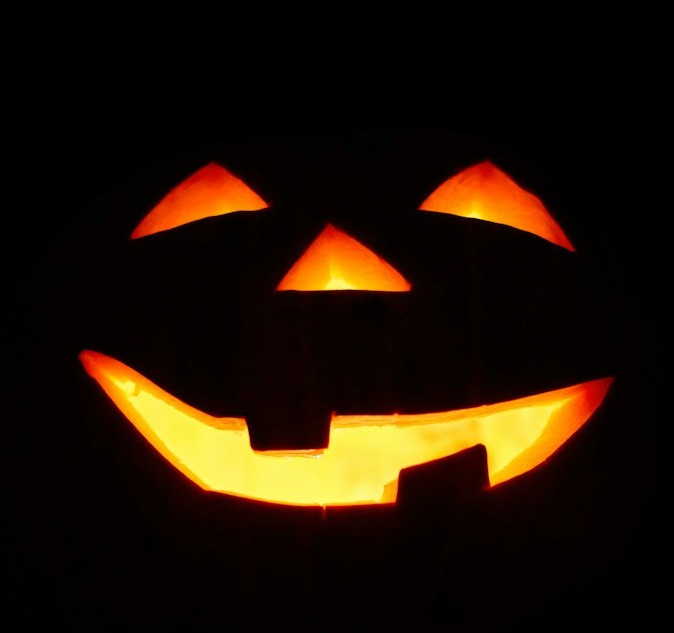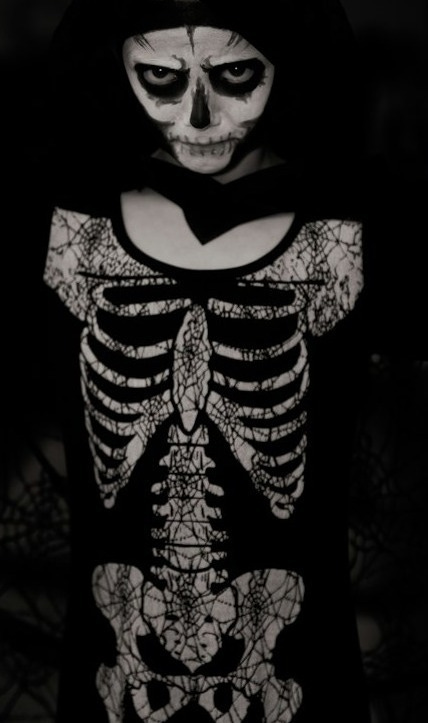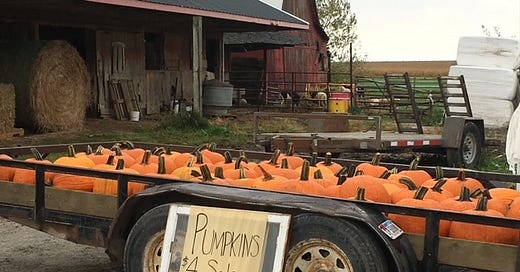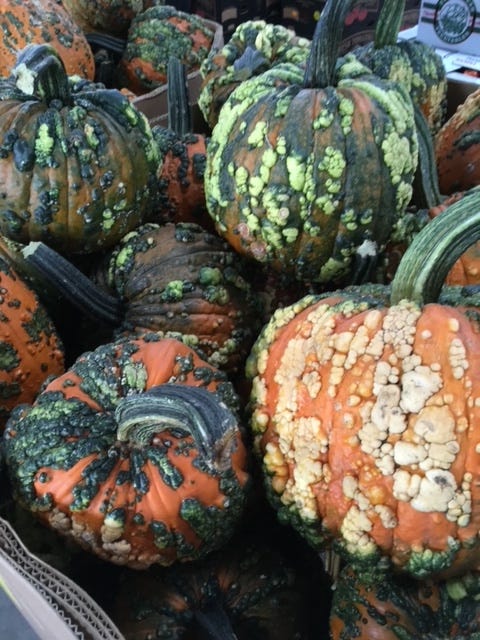The Amish think that Halloween isn’t civilized. The only two things I’ve ever seen the Amish protest were the building of the nearby casino and the celebration of Halloween. The Amish are also discouraged from voting or taking part in anything political, so the protests were unusual, unexpected brave moves.
As a rule, I vote in every election, but I seldom vote early. There is never a line at my precinct polling place just two miles up the gravel road--the Methodist Church with a steeple rising into the blue sky and a slogan of Open Hearts, Open Minds, Open Doors. I descend the stairs into the church basement alone in utter silence. The poll watchers personally thank me every time I blacken the squares next to my candidates’ names and scoot my ballot into the machine.
But it’s hard not to indulge in Halloween in a land filled with pumpkins. Many farmers around here grow pumpkins as a crop, and just about every home gardener includes a few rows in her plot. How can you not carve them into jack-o-lanterns and watch the candles inside flicking and broadcasting their light on the dark, wispy clouds at the end of October?
My neighbors look at it differently. One year, handwritten signs went up at the Amish grocery store: We sell pumpkins but do not observe Halloween. It’s a story of the devil.
Well, indeed, it is. The Irish brought Halloween to the United States with their celebration of Samhain. Celtic farmers thought there was one fall day each year when the season of life met the season of death. On Samhain, the evil spirits could rise from their graves and walk among the living.
On Samhain, Celtic druids tried to predict the survival of their villages through the winter. The priests lit great bonfires and wore costumes, disguising themselves to drive away the spirits. The Catholic Church, of course, wanted to suppress pagan customs. The clergy was famous for inventing and superimposing their holidays on top of Celtic celebrations. By the eighth century, the Church established All Hallows Day on the first day of November. The Holy Father made All Saints Day a holy day of obligation, hoping to bump Samhain right off the calendar.
No such luck. Samhain became known as All Hallows Eve, or Halloween. The early white Protestant settlers, like the Amish, came to the United States with little interest in this heathen holiday. Then in 1845, the Famine Irish came sailing over the Atlantic Ocean, flooding into the States, and carrying their traditions with them.
The scary costumes of the Celts became the modern disguises of Halloween. Trick and treating may be based on the tradition of souling, when the poor went from house to house praying for the souls of each family’s dead in exchange for small cakes to eat.
Jack-o-lanterns may have arisen from the legend of Stingy Jack. Or Jack-o-Lantern, Jack-the-Smith, Jack-the-Drunk, Drunken Jack or Mean Old Smithy. Take your pick. Stingy Jack was a trickster and con-man—cruel, plastered, self-centered and belligerent. Stingy Jack was feared by everyone—from the priest to the children in the schoolyard. Stingy Jack’s bad reputation reached throughout all of Ireland, even to the lowest rung of hell.
Satan had known his share of evil people, but no one like Stingy Jack. The devil decided he needed to take Jack’s soul. One day when Jack was walking in the forest, he saw a dead man swinging from a tree. A wild, wide-eyed face stared at Jack. The jig was up. Jack knew the devil had come to collect his soul.
“I have one request,” Jack said. “Before I depart this world, I would like one last drink in the bar at the casino.”
One drink turned into another and another. The tab grew. Jack tried to convince his new drinking buddy that he could simply turn himself into a silver coin to pay for the drinks. The devil magically transformed himself into a silver coin that Jack conveniently slipped into his pocket.
The devil fought to get out of Jack’s pocket, but he was trapped. A crucifix in Jack’s pocket pressed up against him, keeping the devil a coin. Jack made a deal with the devil.
“You will be released,” Jack told the devil, “If you will let me live another decade.”
The devil could see no other way around it. The bargain was made.
Ten years later, Stingy Jack’s time was up. Again, Jack asked for one more request.
“I want an apple from the orchard to stave off my hunger on this long journey.”
Satan ventured into an orchard and climbed up after an apple. Jack quickly carved four crucifixes into the trunk of the tree. The devil was trapped again.
Once more, Jack struck a deal.
“You can have your freedom,” Jack told the devil, “If I don’t go to hell.”
The devil came down from the tree.
Jack finally passed away, but he was barred from entering the pearly gates. Jack had outwitted the devil. But still, he had lived a drunkard’s deceitful life. So, Jack turned around and headed toward the entrance to hell. Maybe he could get in there. It was better than nothing.
The way to hell was windy and very dark. But Satan also barred the door.
Stingy Jack truly had struck out. He pleaded with the devil to provide him with a light to help him find his way.
Satan, ever accommodating, tossed Jack an ember from the fires of hell. Jack found a rutabaga and hollowed it out, turning it into a makeshift lantern. And ever after that, Stingy Jack’s ghost could be seen wandering around the Irish countryside, Jack-o-lantern in hand.

The Irish people didn’t want Jack’s ghost visiting them. So, every year on Samhain, they carved rutabagas with menacing faces and placed them on their front porches. They put a burning candle inside to drive away Jack and other evil spirits.
In the United States, the Irish found life a bit easier. Pumpkins abounded with much softer rinds than rutabagas and turnips. Soon, large pumpkins became the prized root crop for Halloween jack-o-lanterns.
And Stingy Jack? What became of the man who thought he had outwitted the devil? Jack became condemned on two continents, Europe and America. Here, some of my neighbors have claimed that on Halloween night they’ve seen a strange light knocking on the door of the Methodist Church, only to be turned away.
Others have claimed that they’ve seen that same light wandering between the cars plastered with presidential candidate bumper stickers in the casino parking lot. The light glimmered and wavered, casting shadows through the windows on the roulette wheel inside.

Join us in the Iowa Writers Collaborative Sunday Round-Up. And for paid subscribers, at the Holiday Party in Des Moines on December 13, 2024, 5-8 p.m. at the Harkin Institute.








I'd never heard about Jack's story, Mary. You tell it well. I'll never see a lit Halloween pumpkin quite the same again!
Thanks, Mary, for another entertaining, informative story.